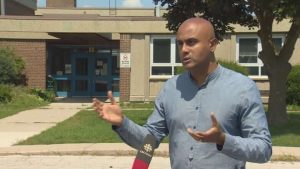Ontario’s largest school board commits to shrinking elementary class sizes in areas hit hardest by COVID-19

A Toronto District School Board (TDSB) trustee says the province’s largest school board will prioritize shrinking elementary class sizes in neighbourhoods hit hardest by COVID-19.
On Friday, Education Minister Stephen Lecce pointed to a number of new investments and policies for school boards announced by the province — among them, $30 million to hire more staff to decrease elementary class sizes whenever possible.
TDSB trustee Parthi Kandavel said the board will be submitting an application for that funding; and while he’s not sure if the funds will be distributed by population or by need, they’re asking for as much as possible to be given to the Toronto District School Board.
“[Toronto] is disproportionately hit, and certain neighbourhoods … are hit the hardest,” Kandavel, who represents Ward 18, Scarborough Southwest, told CBC News.
“We need to address that to ensure the safety of our teachers and of course our students and families.
“The bulk of what we’re counting on for the strategy of reducing class sizes in hardest-hit neighbourhoods, will come down to that provincial fund that’s been set up,” Kandavel added.
In Ontario, there are no cap sizes for kindergarten and classes in Grades 4 through 8, only a maximum average of 24.5 across each board. That means it’s not uncommon for children in high enrolment school boards to find themselves in classes of 30 or more students.
Just over a week ago, Toronto Public Health released startling data showing that Black people or other people of colour made up 83 per cent of all confirmed COVID-19 cases in the city outside of long-term care homes. Previously, the city identified neighbourhoods that have been hit hardest by the novel coronavirus.
In the aftermath, city leaders have called for short-term improvements — like more targeted testing and public awareness campaigns — to better help those most at risk.
However it’s unclear how the data is guiding Ontario’s back-to-school plan.
“I’m hopeful [Lecce will] understand that there’s such an intersection between geography and race, and who lives in these neighbourhoods; and this will hopefully inform their decision to fund Toronto appropriately to [address] these hardest-hit neighbourhoods,” Kandavel said.
Kandavel pointed to Woburn — the eighth most-hit neighbourhood in Toronto — that he said would be given priority in the placement of extra teachers.
He also highlighted other areas “like the Jane and Keele corridor, and in the northwest, there’s Rexdale.”
Many of these harder-hit neighbourhoods are home to higher proportions of crowded multi-unit residences and essential front-line workers.
“The plan is — granted we are given the additional funding from the province, which I suspect will happen — we are going to place those teachers in those hot spots to reduce class sizes,” Kandavel said.
Anusha Kumarasan, whose five-year-old son, Joshua, is going into senior kindergarten — lives in the Woburn area.
She agrees that funding and resources should go to hardest-hit neighbourhoods first. But even if classes are downsized, she is worried about sending her kid to school.
“I’m very nervous about it. I’m leaning more towards online learning than actually sending him because he’s so young,” Kumarasan told CBC News.
“What is he going to know about sanitizing and all that? So I’m very nervous about it. Even if the class was, let’s say 15 students, it will still be nerve-wracking because we don’t know where the kids have been.”
“They’re coming into a classroom and playing together, passing things to each other. It comes down to those little things. I really don’t want to send him back,” Kumarasan added.

Ryan Bird, a TDSB spokesperson, confirmed the board is looking for solutions.
“We’re aware of this issue and are discussing what may be possible with the Ministry of Education,” he said in an email statement.
Last Friday, Premier Doug Ford and Education Minister Stephen Lecce defended the province’s plan but did not give a direct answer when asked if they would spend more to lower class sizes.
“We have to be adaptable,” Ford told reporters. “We have to be flexible — we have been flexible.”
Kandavel said the province is expected to reveal next week how it will be allocating the $30 million funding.
“This is going to be one of those big tests for us and for the public — that we’re meeting the needs of those hardest hit.”
CBC








Redes Sociais - Comentários